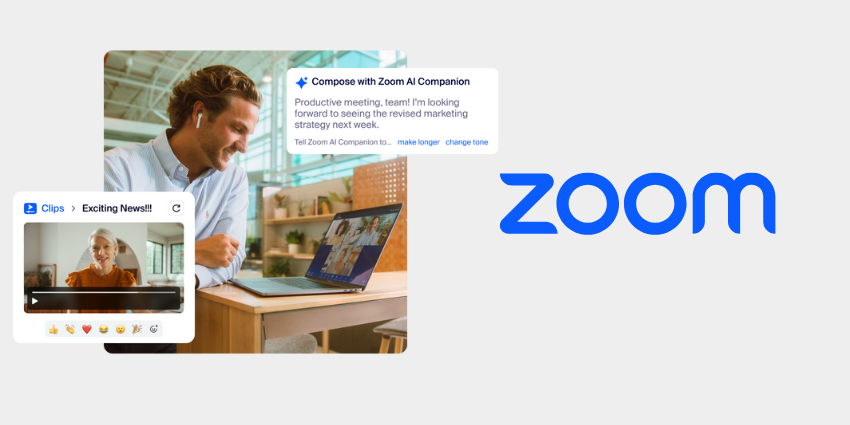Ready to upgrade your corporate collaboration and communication strategy, but not sure which solution you should use? This ultimate Zoom Communications guide will introduce you to everything you need to know about one of the world’s most popular AI-first work platforms.
In 2011, Eric Yuan (Zoom’s founder) set out to solve a problem plaguing professionals worldwide – the headache caused by clunky, unreliable video conferencing tools. Leaving his role at Cisco Webex, he created the Zoom platform designed to make virtual meetings simple and seamless.
Since then, Zoom has evolved on an incredible scale. It’s not just a video conferencing toolkit anymore – it’s a comprehensive work platform combining cutting-edge AI, automation, collaboration, communication, and even customer service solutions.
Whether you’re looking to upgrade business meetings, create cutting-edge virtual classrooms, host immersive online events, or just boost team productivity, here’s everything you need to know about Zoom Communications and the benefits it can bring to your business.
Zoom Communications Guide: Pricing and Fees
Let’s start with one of the most important considerations for any company investing in new collaboration tech: pricing. Like many of its competitors (including Microsoft Teams and Google Workspace) Zoom does have a free plan for beginners.
The Basic plan is pretty generous, offering access to:
- HD Voice and video meetings for up to 40 minutes (slightly less than you’d get on Microsoft Teams’ free plan – but still enough for most simple meetings).
- Up to 100 participants in group meetings (and unlimited Zoom chat).
- Basic meeting features (such as screen-sharing, breakout rooms, and virtual backgrounds).
- Local recording options.
If you’re looking for a straightforward solution for casual calls, and small team meetings, the “Basic” plan is excellent. However, if you want to unlock more of the functionality Zoom offers (like unlimited Clips, cloud recording, REST API access, etc), you’ll need to consider a paid plan.
The Premium Plans: Pro, Business and Enterprise
Currently, there are three “paid” plans available for Zoom users: the Pro plan, Business plan, and Enterprise plan. Here’s what you get with each option:
- Pro: $15.99 per month (or $13.33 per month billed annually): All the features of the Basic plan, 30-hour meeting durations, 5GB of cloud recording per license, free premium Zoom apps for 1 year, and the Zoom mail service. You also get Zoom AI Companion, a Calendar service, unlimited Zoom Clips, unlimited Zoom Docs, toll-based telephone dial in options, polling, co-hosts, REST API access, and more.
- Business: $21.99 per month (or $18.32 per month billed annually): All the features of the Pro plan, plus 300 participants in group meetings, unlimited zoom whiteboards, a custom mail domain, Zoom scheduler, admin tools, recording transcripts, branding, managed domains, and dedicated phone support.
- Enterprise: Custom pricing: All the features of the Business plan, plus up to 1,000 meeting participants, Clips Plus, visitor management, Zoom Phone, unlimited cloud storage, dedicated customer success manager, advanced analytics, and more.
Zoom Communications Guide: Add-Ons and Extras
If you want to take Zoom’s functionality to the next level, you can purchase a handful of add-ons and extras to accompany your plan. One thing that makes Zoom really stand out here, is that you don’t have to pay for “AI Companion” separately – that’s included in your paid plan already. However, there are fees for things like:
- Zoom Scheduler: $4.99 per month/per user (billed annually) for the basic Scheduler, or $18.32 per month per user, for Scheduler + Zoom Pro.
- Rooms: $41.58 per user per month (billed annually), or $54.91 per month, per user, for Rooms + Zoom Pro.
- Whiteboard: Starting at $2.07 per month per user, or $5.83 per month per user with Whiteboard Plus.
- Zoom Docs: Starting at $7.49 per month per user (as an add-on to the free plan).
- Clips Plus: Starting at $5.83 per month, per user (billed annually).
Plus, you can purchase Zoom Phone subscriptions separately (starting at $15 per month per user) and additional cloud storage – regardless of which central plan you’re using.
Zoom Communications Guide: The Features of Zoom
As mentioned at the start of this Zoom communications guide, Zoom is more than just a video conferencing platform. The full suite of solutions offered by Zoom covers everything from the “Zoom Workplace” solution (all the tools needed for day-to-day productivity and collaboration), to Zoom’s Business Services, APIs, app marketplace, devices, and beyond, including several underrated Zoom features.
Here’s a quick look at everything businesses can access.
Zoom Workplace: Communication, Productivity, Spaces and More
Zoom Workplace is essentially Zoom’s all-in-one solution for communication, collaboration, and productivity. This platform has evolved significantly in recent years, adding new features like AI-powered tools, workspace reservation apps, and even Workvivo for employee engagement:
Zoom Communications
From a communications perspective, Zoom comes with everything you’d expect from a collaboration-first platform; you can access:
- Meetings: High-quality video conferencing sessions with built-in features for recording, transcription and translation, virtual backgrounds, screen sharing, and more.
- Team Chat: Zoom’s instant messaging platform supports file sharing, group chats, GIFs, one-on-one messaging, and flexible search tools.
- Phone: Zoom Phone is a modern cloud-based system offering features like call routing, voicemail transcription, and SMS summary threads.
- Mail & Calendar: Zoom’s integrated email and calendar services help users manage their daily communications and schedules within the Zoom platform, as well as integrating with room booking tools.
- Scheduler: This tool removes the hassle of traditional appointment scheduling by allowing users to share their availability and book appointments efficiently
Zoom Spaces:
- Rooms: Designed to make in-person and hybrid meetings more effective and inclusive, Zoom Rooms link high-quality video conferencing with features like wireless content sharing and interactive whiteboarding.
- Workspace Reservation: This feature allows employees to reserve desks, rooms, or other workspaces in advance, making it easy to keep hybrid and remote teams aligned.
- Visitor Management: For companies that manage a lot of visitors, Zoom visitor management makes it simple to invite and register visitors to locations, track their arrival, and maintain logs for security purposes.
- Digital Signage: Keep employees informed with interactive content displayed on digital screens throughout the workplace, sharing company updates, announcements, or even just celebrating milestones.
Zoom Productivity and Engagement Tools
- Workvivo: The Workvivo platform, built into Zoom Workplace is designed to keep teams aligned with activity feeds, goals, shout-outs, community spaces, and more. You can even share surveys and polls, and access “content analytics” to track team connections.
- Whiteboard: Just like the whiteboarding tools available on Teams, Zoom’s whiteboard gives employees a virtual canvas where they can sketch out ideas, comment on content, and annotate documents in real-time.
- Zoom Tasks: Zoom’s task management tool helps employees stay on-top of projects. AI companion can automatically detect tasks from meetings and calls, assign them to staff members, and even mark them as complete once they’re done.
- Surveys: Integrated into the Zoom collaboration suite, surveys allow companies to quickly gather feedback from team members before, after, and during meetings.
- Docs: Zoom’s Docs solution, built with AI companion at its core, instantly enables flexible solutions for content creation and asynchronous collaborative workflows. It’s fully integrated with Zoom meetings, so you can chat with colleagues while you work.
The Zoom productivity suite also includes Notes (to help you prepare for and manage meetings more effectively) and Zoom Clips – an AI-enhanced tool for recording and sharing short video messages.
- What about Zoom Phone? Read our analysis of how Zoom Phone delivers value for forward-thinking businesses over traditional VoIP here.
Zoom Business Services: Marketing, Sales and Beyond
Zoom’s business services solutions address the needs of specific groups and team members within modern organizations. For instance, if you want to combine your unified communication and contact center tools, you can access Zoom’s customer experience solutions. Alternatively, if you’re looking for a way to upgrade your marketing strategy, Zoom offers tools for online events and webinars:
- Marketing Tools: For marketing, Zoom offers access to Zoom Events (for virtual experiences like large-scale conferences), Zoom Webinars (which can host up to 50,000 participants), and Zoom Sessions (designed for smaller-scale events).
- Customer Experience: Zoom’s Customer Experience tools basically give your employees everything they need to support, serve, and delight customers. You can access the Zoom contact center with built-in AI assistants, omnichannel communication support, call routing, automation, and analytics. There’s the Zoom Virtual Agent which can deliver 24/7 service to customers across channels, recognize customer intent, and handle complex inquiries. Plus you can also access Zoom’s Workforce engagement tool with built in quality management, scheduling, forecasting, and coaching capabilities.
- Sales: Explicitly designed for sales teams, the Zoom Revenue Accelerator enhances productivity and shortens sales cycle, with extensive conversational intelligence. It integrates seamlessly with Zoom Meetings and Zoom Phone, as well as numerous CRM platforms and business productivity tools.
Zoom Communications Guide: AI Companion
Zoom AI Companion is one of the most exciting parts of the Zoom ecosystem, built into virtually every feature and tool the company offers. This intelligent assistant was updated in 2025 with new capabilities to help employees accomplish more with less.
Zoom AI Companion can summarize and analyze meetings, documents, chat threats, and phone calls, help you brainstorm new ideas, and generate content for marketing and sales teams. It can draw on various “large language models” – including solutions built by Meta, Anthropic, and OpenAI – and you can even create avatars for Zoom Clips with the AI model.
Zoom’s AI companion can draft emails and chat messages based on prompts, answer questions about the content in different documents, suggest next steps after a call, and so much more. Plus, as we mentioned earlier in this Zoom Communications guide, AI Companion is included in all of Zoom’s paid plans with no extra fees. That distinguishes Zoom from companies like Google and Microsoft, who both charge extra for access to their AI tools.
Notably, though – some additional features will come with an extra cost. For instance, just like Microsoft offers its “Copilot Studio” to allow teams to fine-tune their generative AI tools, Zoom is introducing its own “Zoom AI Studio”. The studio will be a “paid add-on” option or select plans.
The Flexible Zoom Ecosystem: Partners, Apps and APIs
If you’re looking for flexibility in your communication and collaboration platform, it’s hard to go wrong with Zoom. Over the years, Zoom has established various partnerships with organizations like AWS (for scalable cloud solutions), and HP/Poly, Mitel, and others for hardware.
Beyond that, Zoom has one of the biggest app marketplaces in the industry, with more than 2,000 apps to explore. You can connect Zoom directly to tools for education, finance management, scheduling, customer service, design, and more. Zoom even supports direct integrations with Microsoft’s Office apps, and Google’s Workspace tools.
If you need to build something unique, Zoom also offers a comprehensive suite of APIs for custom applications and integrations. There’s a huge range of tools to choose from, including an SDK that ensures you can bring video, audio, screen sharing, chat, and other features into your existing apps.
On top of all that, there’s no limit to devices and endpoints you can use with Zoom either. Zoom works with AV partners to create comprehensive meeting room kits for small, mid-sized, and enterprise-scale businesses and companies in specific industries like healthcare and education.
The vendor even has a dedicated list of “certified” hardware vendors to choose from, which include SIP phones, appliances, controllers, cameras, speakerphones, and virtually anything else you might need to keep your team connected.
Zoom Communications Guide: Security and Compliance
Zoom’s approach to security hasn’t always been the best. In the past, security gaps were pretty standard for the collaboration leader. The Zoom iOS app was found to be sending data to Meta in 2020. Gaps in the company’s encryption strategy also led to uninvited guests joining meetings.
Fortunately, as demand for collaboration platforms increased, Zoom’s team didn’t waste time fixing these issues. The company announced a 90-day security plan in 2020, and introduced more than 100 new safety features to the platform, focused entirely on keeping data safe.
Zoom’s platform now offers end-to-end encryption, comprehensive access controls, enhanced privacy policies, and even password-protected waiting rooms and meetings. Zoom even announced in 2024 that it was working on adding post-quantum cryptography to its platform.
Still, even though Zoom is a lot safer to use today, it’s worth ensuring you’re following standard security best practices on the platform. In other words:
- Use passcodes to lock meetings and prevent access from external parties.
- Create waiting rooms so you can double-check participants before starting a meeting.
- Use secure storage methods to protect files and recordings.
- Enable two-factor authentication for Zoom users.
- Keep your Zoom software up-to-date and train team members on safe usage policies.
Zoom Communications Guide: Influencers to Follow
Still need more insights into Zoom and what it can do for your company? You can find plenty of guides, reviews, and articles (as well as all the latest Zoom news) right here on UC Today. However, if you’re looking for more perspectives, here are some top Zoom influencers worth following:
- Patrick Kelley: Patrick Kelley, or the “Tattooed Nerd” regularly shares behind-the-scenes insights into leading business software and platforms. Check out his comprehensive Zoom playlist for insights into how to make the most of all of Zoom’s features.
- Zeus Kerravala: One of the world’s leading independent analysts, Zeus always has valuable information to share about the latest AI tools, collaboration platforms, and business software. He also regularly interviews other world-leading influencers, like Dave Michels.
- Dave Michels: Another well-known technology influencer and thought leader, Dave Michels of Talking Points is a great person to follow if you’re looking for news on collaboration and communication trends or AI-powered tools.
- Kevin Stratvert: Former Microsoft employee, Kevin Stratvert, publishes comprehensive guides on various software tools. His Zoom tutorials are great for those who might just be diving into the platform for the first time.
- Steve Dotto: Steve Dotto (Dotto Tech) has created hundreds of videos showing users how to get the most value out of platforms like Zoom, Google Workspace, Microsoft Teams, and more. Check out his full playlist on Zoom video conferencing basics.
Is Zoom Right For You?
So, how do you decide if Zoom is right for you? Hopefully, this Zoom communications guide has given you a clear overview of the top features and benefits of Zoom’s AI-powered work platform. However, it’s worth remembering that this platform is constantly evolving.
Most significantly, Zoom has gone all-in on its AI strategy in the last couple of years, enhancing its AI companion and infusing it with every part of the Zoom ecosystem. The company wants to create the ultimate “intelligent” space for work – empowering sales, marketing, and customer service teams to accomplish more with the latest innovative tools.
Of course, Zoom is far from the only company offering organizations a comprehensive AI-powered toolkit. Microsoft provides a very similar experience with Microsoft Teams and Copilot, and Google offers Gemini for Workspace. Notably though, as mentioned above in this Zoom communications guide, both of those competitors charge extra for access to AI tools.
Compared to other platforms, Zoom might be ideal for you if you’re looking for:
- Comprehensive built-in AI (without any extra fees).
- Flexible tools for contact center, workforce management, and employee engagement.
- Easy-to-use and intuitive video conferencing tools.
- Flexible APIs, SDKs, and thousands of connected apps.
Zoom Communications FAQs
What is Zoom and how does it work?
Zoom is an AI-powered platform that allows users to host and join virtual meetings, webinars, and events. It offers video, audio, chat, screen sharing, and collaboration tools across desktop, mobile, and web applications, as well as the Zoom AI Companion.
Is Zoom free to use?
Zoom offers a free “Basic” plan with unlimited one-on-one meetings and chat and group meetings with up to 100 participants for 40 minutes. Paid plans, however, do offer access to a wider range of features, including Zoom AI Companion.
Can I use Zoom on any device?
Yes! Zoom is available on Windows, macOS, iOS, Android, and web browsers. There are also Zoom-compatible hardware devices for meeting rooms, and some partners offer comprehensive room kits for “Zoom Rooms.”
Is Zoom secure?
To enhance security, Zoom has end-to-end encryption (E2EE) for meetings, waiting rooms, meeting passcodes, and two-factor authentication (2FA). However, you’ll still need to follow security best practices to avoid potential risks.
Does Zoom integrate with other apps?
Zoom integrates with Slack, Microsoft Teams, Google Workspace, Salesforce, Trello, Asana, and over 2,000 apps through the Zoom App Marketplace. There are also SDKs and APIs available from Zoom for custom integrations.







